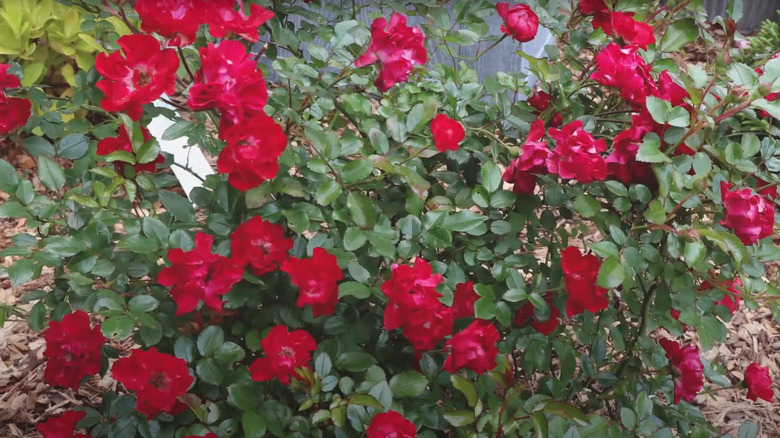The Disease-Resistant Variety Of Garden Roses That You Can Use As A Ground Cover
Ground covers don't have to be boring, but if you're looking for one with a little extra pizzazz, we may just have a winner for you. The "It's a Breeze" rose (Rosa hybrid 'Meigremlis') is a low growing rose that produces a profuse cluster of red blooms on each stem. It will grow to about 2 or 3 feet in height and up to 4 feet wide, making quick work of covering plenty of ground. Additionally, it blooms from spring through fall, making its deep red flowers a great source of season-long color.
Ground cover roses are not new. However, this rose's many attributes make "It's a Breeze" an especially good choice for gardeners looking for an easy ground cover that brings more than just utility to the garden. The plants are hardy in USDA zones 4 through 11, making them a good choice no matter your climate. And, if you live in a warmer climate, you can add these roses to your list of evergreen ground covers that provide year-round color, because they are semi-evergreen, ensuring you have foliage even in mild winters. Perhaps the best news of all? This rose variety is considered particularly disease resistant. That doesn't mean it's exactly pest resistant though, so if you have deer in your neighborhood, you may find them munching on these beauties.
Caring for your It's a Breeze rose
At the risk of sounding cheesy, caring for "It's a Breeze" should, in fact, be a breeze. To start, we highly recommend learning the tips and tricks for planting ground cover roses. Like most roses, this one prefers full-sun and rich, well-drained soil. So, if you have heavy, clay soil, add organic material when you plant "It's a Breeze" to ensure you get it off to a good start. Another benefit of this rose is that it can tolerate a wide range of pH levels, so you won't need to worry much about that aspect of your soil.
This is a heat-tolerant rose, but while it's getting established, be sure to water at least two to three times per week — more if you hit a particularly hot or dry spell. You will also want to add a slow-release fertilizer in the spring to ensure it blooms right up through the fall. Trim the bushes between blooms to get the best results. In the late-spring or early-winter, cut them back by up to one-third. This will help ensure you get compact growth, which may be especially important for ground cover uses. This easy-to-care-for rose is beginner-friendly, but you can up your garden game with expert tips for perfecting your rose garden soil.

